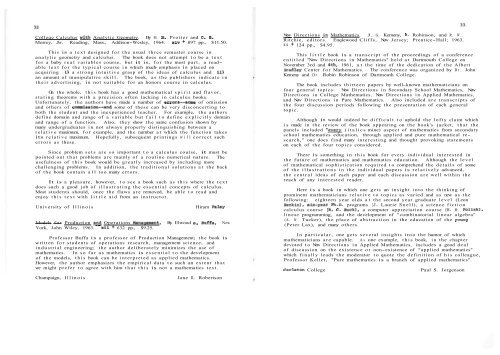Vol. 4 No 1 - Pi Mu Epsilon
Vol. 4 No 1 - Pi Mu Epsilon
Vol. 4 No 1 - Pi Mu Epsilon
You also want an ePaper? Increase the reach of your titles
YUMPU automatically turns print PDFs into web optimized ePapers that Google loves.
Colleqe Calculus w& Analytic Geometry. By M. H. Protter and C. B.Morrey, Jr. Reading, Mass., Addison-Wesley, 1964. xiv + 897 pp., $11.50.This is a text designed for the usual three semester course inanalytic geometry and calculus. The book does not attempt to be a textfor a baby real variables course, but it is, for the most part, a readabletext for the typical course in which much- emphasis is placed onacquiring i) a strong intuitive grasp of the ideas of calculus and ii)an amount of manipulative skill. The book, as the publishers indicate intheir advertising, is not suitable for an honors course in calculus.On the whole, this book has a good mathematical spirit and flavor,stating theorems with a precision often lacking in calculus books.Unfortunately, the authors have made a number of errors~some of omissionand others of commission~and some of these can be very disconcerting toboth the student and the inexperienced teacher. For example, the authorsdefine domain and range of a variable but fail to define explicitly domainand range of a function. Also, they show the same confusion shown bymany undergraduates in not always properly distinguishing between arelative maximum, for example, and the number at which the function takesits relative maximum. Hopefully, subsequent printings will correct sucherrors as these.Since problem sets are so important to a calculus course, it must bepointed out that problems are mainly of a routine numerical nature. Theusefulness of this book would be greatly increased by including morechallenging problems. In addition, the traditional solutions at the backof the book contain all too many errors.It is a pleasure, however, to see a book such as this where the textdoes such a good job of illustrating the essential concepts of calculus.Most students should, once the flaws are removed, be able to read andenjoy this text with little aid from an instructor.University of IllinoisHiram Paley--Models for Production @ Operations Management. By Elwood S. Buffa. NewYork, John Wiley, 1963. xii + 632 pp., $9.25.Professor Buffa is a professor of Production Management; the book iswritten for students of operations research, management science, andindustrial engineering; the author deliberately minimizes the use ofmathematics. In so far as mathematics is essential to the developmentof the models, this book can be interpreted as applied mathematics.However, the author emphasizes the empirical data to such an extent thatwe might prefer to agree with him that this is not a mathematics text.Champaign, IllinoisJane I. Robertson- New Directions &I Mathematics. J. G. Kemeny, R. Robinson, and R. W.Ritchie, editors. Enqlewood Cliffs, New Jersey; Prentice-Hall; 1963.ii + 124 pp., $4.95.This little book is a transcript of the proceedings of a conferenceentitled "New Directions in Mathematics" held at Dartmouth College on<strong>No</strong>vember 3rd and 4th, 1961, at the time of the dedication of the AlbertGradley Center for Mathematics. The conference was organized by Dr. JohnKemeny and Dr. Robin Robinson of Dartmouth College.The book includes thirteen papers by well-known mathematicians onfour general topics: New Directions in Secondary School Mathematics, NewDirections in College Mathematics, New Directions in Applied Mathematics,and New Directions in Pure Mathematics. Also included are transcripts ofthe four discussion periods following the presentation of each generaltopic.Although it would indeed be difficult to uphold the lofty claim whichis made in the review of the book appearing on the book's jacket, that thepanels included ''m(italics mine) aspect of mathematics from secondaryschool mathematics education, through applied and pure mathematical research,"one does find many interesting and thought provoking statementson each of the four topics considered.There is something in this book for every individual interested inthe future of mathematics and mathematics education. Although the levelof mathematical sophistication required to comprehend the details of someof the illustrations in the individual papers is relatively advanced,the central ideas of each paper and each discussion are well within thereach of any interested reader.Here is a book in which one gets an insight into the thinking ofprominent mathematicians relative to topics as varied and as new as thefollowing: eighteen year olds at the second year graduate level (Leonen kin), six-year Ph.D. programs (J. Laurie Snell), a science fictioncalculus course (R. C. ~uck), a computer appreciation course (H. 0. Pollak),linear programming, and the development of "combinatorial linear algebra"(A. W. Tucker), the place of abstraction in the education of the young(Peter Lax), and many others.In particular, one gets several insights into the humor of whichmathematicians are capable. As one example, this book, in the chapterdevoted to New Directions in Applied Mathematics, includes a good dealof discussion on the existence or non-existence of "applied mathematics"which finally leads the moderator to quote the definition of his colleague,Professor Keller, "Pure mathematics is a branch of applied mathematics".Carleton CollegePaul S. Jorgenson
















